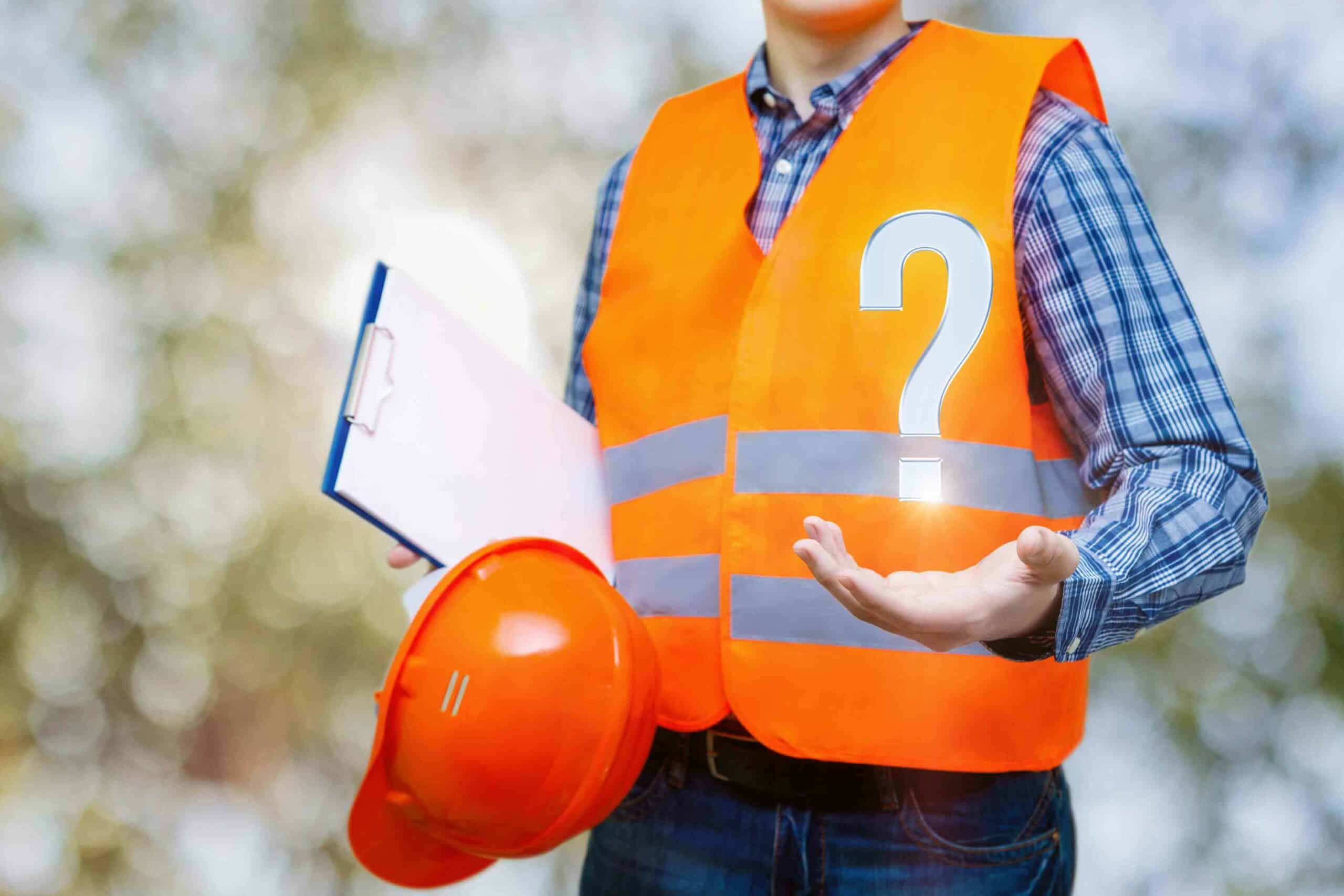Renting a crane offers many advantages for construction, industrial, and infrastructure projects. It can help cut down on capital expenses, provide access to specialized equipment, and facilitate efficient workflows. However, to get the most out of crane rentals, it’s essential to make wise choices that align with your project’s needs.
This guide walks contractors, project managers, and developers through the key considerations to keep in mind before renting a crane. From understanding your project’s scope and technical requirements to clarifying budget considerations and logistical details, each step helps confirm the equipment you choose aligns appropriately with your needs. Additionally, partnering with trusted professionals, such as Maxim Crane, can simplify the process through expert insights and flexible solutions tailored to your project.
Determine Project Needs Before Renting a Crane
Before exploring crane rental options, take a moment to evaluate your project’s specific requirements. Every construction, industrial, or infrastructure development has distinct demands, and clarifying these early on helps you select equipment best suited for the job. Consider:
- What materials or equipment require lifting, and how heavy are they?
- How frequently will lifts be required during the project timeline?
- Are there limiting factors like tight spaces, congested urban environments, or rugged terrain?
By outlining your objectives, you can identify the most appropriate resources for your undertaking. Large-scale initiatives such as stadium or skyscraper projects may require more robust cranes with extensive capabilities, while smaller commercial builds may benefit from moderately sized machinery. In certain situations, specialized rigging equipment or specific crane types might also be needed.
Doing this groundwork narrows down potential crane choices and positions you to collaborate with industry professionals, such as those at Maxim Crane. Their insights can help you match the right equipment to your project’s parameters.
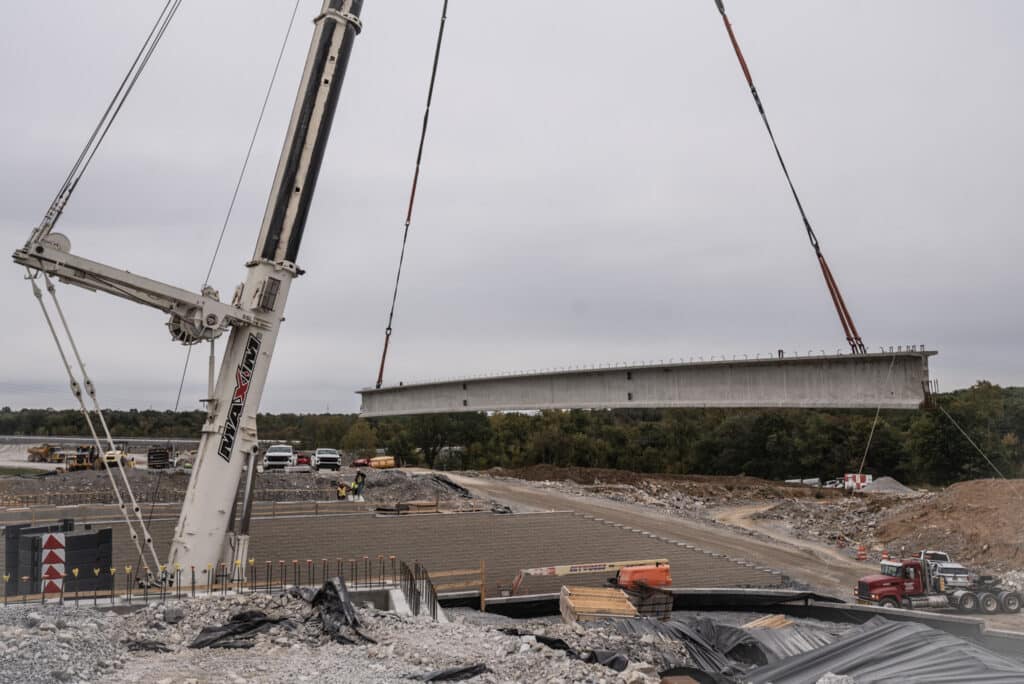
Evaluate Load Specifications and Requirements
Choosing the right crane begins with a thorough review of your load specifications. Before making any decisions, compile a detailed list of the materials or tools you need to lift, including their weights and dimensions. Precise calculations—such as total load weight, height, width, and shape—support selecting a crane with the suitable capacity.
Pay special attention to especially heavy or voluminous items, as these often determine the core capacity requirements. Additionally, consider the load’s center of gravity, which influences how it must be supported during lifting. This approach helps in choosing a crane that delivers the needed performance without creating unplanned complications.
For added clarity, you can involve professionals from Maxim Crane’s engineering services team. Their industry experience includes validating load specifications and determining compatible equipment. By delving into these specifics early, you can avoid underpowered or excessively large equipment that may increase costs.
Choose the Right Crane for the Job
Deciding on the ideal crane type is one of the most crucial parts of the rental process. Cranes vary widely, from all-terrain and rough terrain cranes to crawler models, each designed for particular site conditions and load requirements.
Begin by identifying core criteria for your lifting tasks:
- Maximum Height: The vertical reach required for the highest lift.
- Lifting Distance: The radius from the crane’s center to where the load will be placed.
- Terrain Conditions: Whether the ground is smooth, uneven, or has limited space.
For instance, all-terrain cranes are practical when balancing on- and off-road needs, while crawler cranes are popular for large-scale, longer-term tasks where robust lifting capacity and stability are essential. Rough terrain cranes may be advantageous when dealing with uneven or rugged ground where maneuverability is limited.
Choosing a crane that closely matches your project’s requirements promotes cost-effectiveness and efficient performance. With support from specialists, you can evaluate your options based on factors such as terrain, reach, and weight capabilities. This approach can help you select equipment that’s well-suited to your project’s demands, ensuring maximum performance and safety.
Decide on Crane Rental Duration and Budget
Determining the crane rental timeframe is pivotal for managing both schedule and costs. Some endeavors need a crane for only a few days, while others may require access to lifting equipment for weeks or months. Accurately estimating the overall rental period helps you focus on realistic budgeting and keeps the project on track.
Start by mapping out your major tasks, including preparation, assembly, and disassembly. If unfamiliar weather patterns or supply chain delays are potential concerns, build contingencies into your planned usage span. Also, note that larger cranes frequently require multiple deliveries for attachments like counterweights—a factor that can lengthen setup and dismantling timelines.
Striking the right balance between crane capability and rental duration can significantly influence costs. Selecting a model that’s too large might lead to unneeded expenses, while picking a smaller option could create inefficiencies on more extensive assignments. It’s also worth noting that optimal crane availability, particularly for large-scale assignments, might be limited. Reserving equipment early and negotiating flexible terms can help you secure the right resources and keep costs under control. Consulting with Maxim Crane’s rental team can provide insights into cost-effective solutions that align with your needs.
Plan Crane Placement on the Jobsite
Crane placement is a key consideration for achieving uninterrupted workflows. Cranes need ample room to assemble and maneuver, and their deployment can substantially affect the efficiency of your overall operations. Elements such as site design, terrain characteristics, and equipment demands inform where and how you install the crane.
Begin with a site plan, pinpointing potential obstructions like buildings or restricted zones. Assess how the crane’s operational radius aligns with the tasks at hand. Minimizing the number of times the crane must be moved speeds up processes and controls costs.
Stability is another critical factor. Identify whether the ground can support the crane’s heavy load requirements, including any counterweights. In instances where terrain is inconsistent or soft, extra measures—like constructing pads—might be needed. Consider the crane’s reach and how its jib or boom can support the necessary lifting height. If the crane’s footprint is too large, it may be challenging to position it in a way that supports the needed range. In these situations, it might be necessary to consider alternative models or configurations.
Collaborating with a professional crane supplier can help you analyze your site layout and choose the appropriate crane setup. Maxim Crane offers crane consulting services that help you select the most suitable equipment and devise a plan that supports efficient use. This approach can help you avoid costly delays or disruptions.
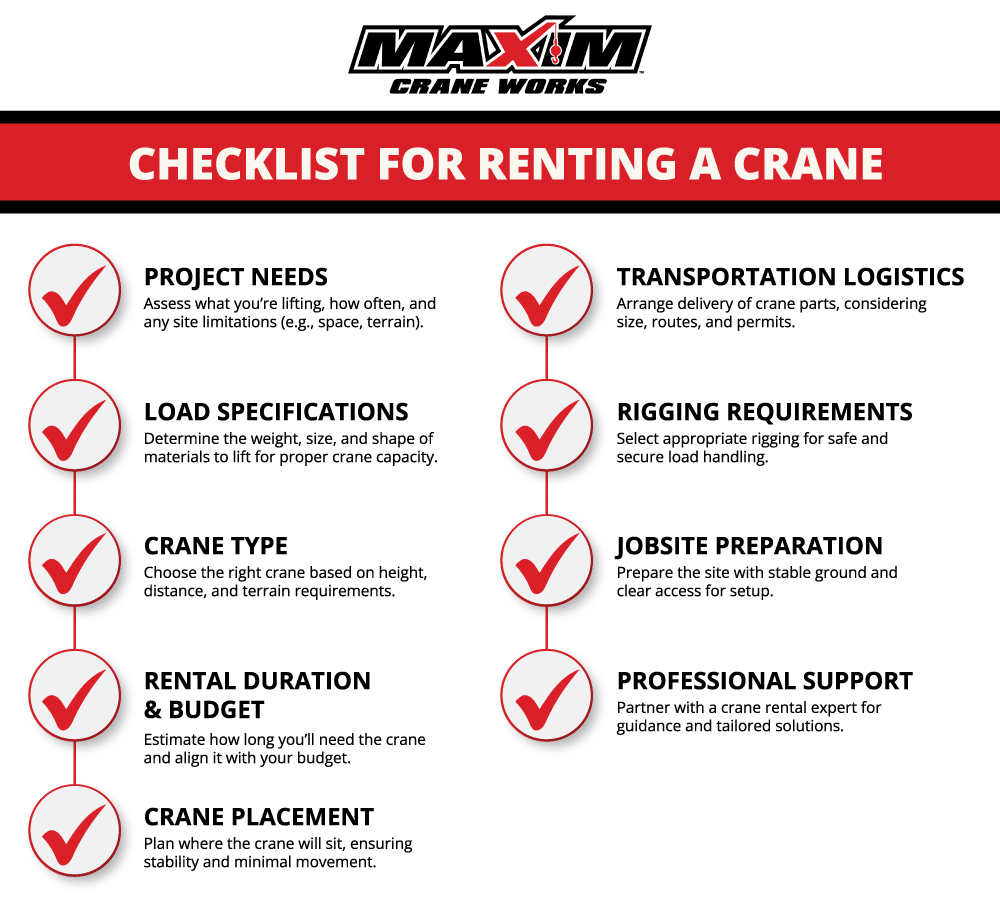
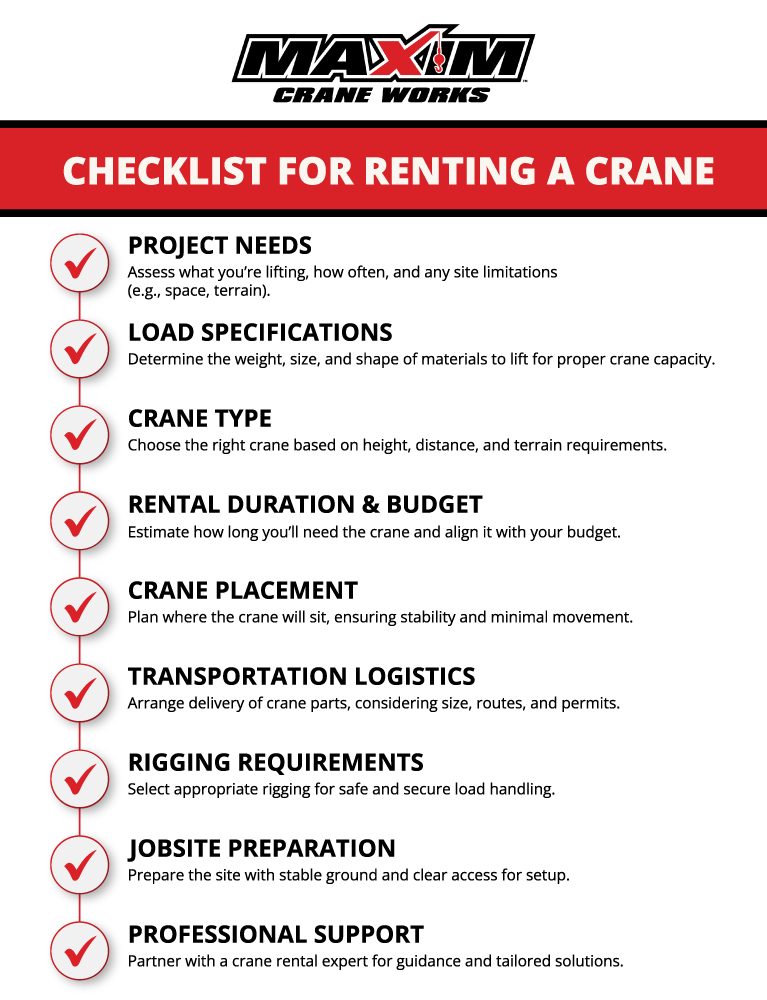
Plan Transportation and Delivery Logistics
Coordinating the transport and delivery of crane components can be a substantial undertaking, particularly for large or technically sophisticated jobs. Booms, jibs, and counterweights might need to travel on separate trailers, requiring you to account for factors like site accessibility and important regulations.
In structuring your transport schedule, consider the crane components’ size and weight to determine the most practical routes. Some areas impose special permits for oversized loads, so arrange any approvals in advance to avoid scheduling disruptions. Identify an appropriate staging area where the crane parts can be unloaded and prepared for assembly without interrupting other site activities.
Maxim Crane’s Heavy Hauling Solutions can support you in navigating these logistics. Their team can provide insights into the most efficient transport strategies, including the handling of oversized loads. By partnering with experienced professionals, you can streamline one of the critical stages of your crane rental process.
Understand Rigging and Load Connection Requirements
Rigging is integral to connecting loads to cranes effectively. It encompasses tools and procedures that secure and elevate materials, whether you’re working with standard slings or more advanced systems for large-scale lifts. By choosing the right rigging solutions, you can promote stable, precise lifts for every aspect of your project.
Assess the exact needs of your load by reviewing dimensions, shape, and balance. Irregularly shaped or off-center items often call for tailored rigging setups. Consulting technical plans or engineering data provides insight into where attachment points should be placed. This type of preparation reduces potential complications or slowdowns once lifts begin.
Consider collaborating with the rigging specialists at Maxim Crane. Their expertise can help outline methods that align with your project’s chosen lifting strategy. Taking the time to map out these details thoroughly can support efficient load handling and help you maintain momentum.
Prepare the Jobsite for Crane Usage
Preparing the jobsite is central to promoting an efficient project experience once the crane arrives. Identifying factors like ground composition, on-site obstructions, and clear access paths keeps the setup process smooth and schedules more predictable.
Evaluate the surface conditions first. Cranes function best on firm, level ground that supports the total weight of the crane and its counterweights. If the soil or terrain is uneven or prone to shifting, additional stabilization might be required. On especially large endeavors, a geotechnical survey can clarify whether special support measures are needed.
Next, examine your space constraints. Clear any leftover debris and confirm you have room to place crane components, such as jibs or booms, without affecting other site activities. Plan how you’ll route vehicles that deliver crane parts to avoid unnecessary congestion. If you have limited space, staging equipment efficiently can keep tasks moving along in a steady manner.
Experienced providers can offer guidance for optimizing the layout of your site. With many locations across the country, Maxim Crane brings insights into diverse project scenarios, helping you finalize arrangements that facilitate straightforward crane usage.
Work with a Professional Crane Rental Provider
Teaming up with a professional crane rental supplier can simplify both large and small-scale undertakings. A top-tier provider, such as Maxim Crane, offers an expansive range of equipment and extensive knowledge across commercial, industrial, and infrastructure domains. Their know-how helps you pinpoint cranes suited to your project’s specifics, whether you’re honing in on high-capacity crawler cranes or more compact all-terrain models.
Involving seasoned professionals early in your planning—by sharing project details like load dimensions and site constraints—can be highly advantageous. These specialists recommend efficient solutions, offer actionable timelines, and propose cost-saving options. Collaboration on topics such as crane selection, logistics, and scheduling fosters more productive results.
Maxim Crane offers a comprehensive range of services that support every phase of your project. Their robust service portfolio, engineering expertise, and heavy hauling solutions can guide projects of all scales, ensuring efficient execution and optimal results.
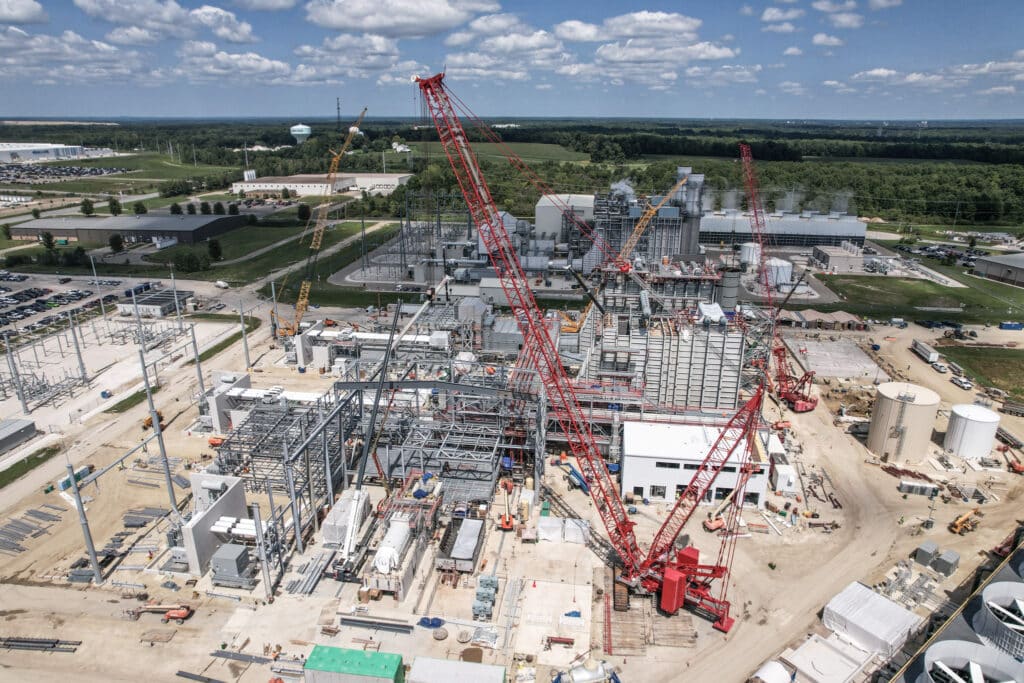
Optimize Your Crane Rental to Ensure Project Success
Renting a crane calls for careful analysis of your project’s objectives, load details, site logistics, and budget targets. By clarifying these items early in the process, you can select equipment and develop a clear plan that supports effective and dependable results. An experienced provider, such as Maxim Crane, offers a broad fleet of cranes and a team well-versed in tailoring solutions to match projects of all scopes.
If you’re looking to streamline your construction or industrial project with high-quality lifting services, contact the Maxim Crane team to learn more about how their offerings might fit your needs. Their team of professionals are ready to guide you at every stage, helping your project progress efficiently and reach successful outcomes.


